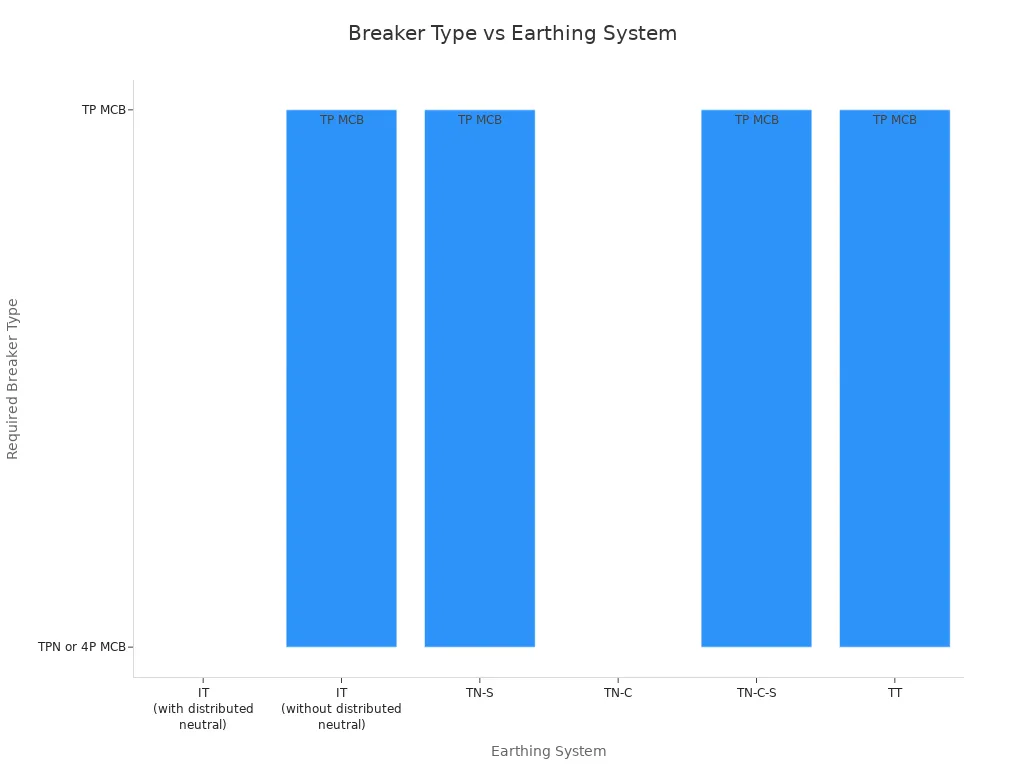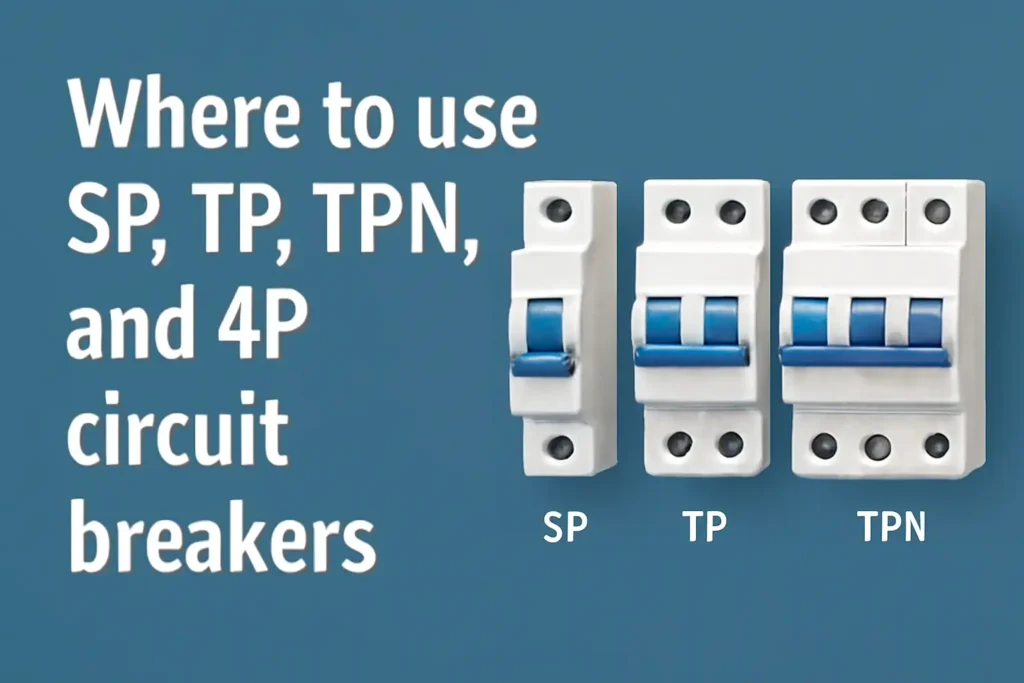You find different circuit breaker types for specific needs:
- Use SP in small home circuits.
- Choose SPN for single-phase loads with neutral.
- Tandem breakers fit crowded panels in homes.
- TP suits three-phase motors in factories.
- TPN works for three-phase systems needing neutral.
- Pick 4P for four-wire three-phase setups.
Selecting the right circuit breaker protects you from electrical hazards. You keep your system safe and meet regulations.
Key Takeaways
- Use SP breakers for simple home circuits like lights and outlets. Use SPN breakers when you need to switch both phase and neutral for more safety.
- Pick TP breakers for three-phase systems that do not have neutral. Use TPN breakers if you need to switch the neutral too. Use 4P breakers for full protection, including neutral, in important or uneven systems.
- Tandem breakers let you add more circuits in crowded home panels. Only use them if your panel allows it, so you stay safe and follow rules.
- Always match your circuit breaker to your system’s voltage, current, earthing type, and load. This keeps you safe and follows local rules.
- Turn off the main power and wear safety gear when putting in breakers. Ask a licensed electrician for help with hard or important jobs to keep you and your system safe.
Circuit breaker types

| Circuit Breaker Type | Definition (Pole Configuration) | Primary Application |
|---|---|---|
| SP (Single Pole) | Single pole switching and protection on one phase only | Single phase supply, breaking phase only |
| SPN (Single Pole and Neutral) | Single pole plus neutral pole, neutral switched but not protected | Single phase supply, breaking phase and neutral |
| TP (Triple Pole) | Three poles switching and protection on three phases, neutral not included | Three phase supply without neutral |
| TPN (Triple Pole and Neutral) | Three poles plus neutral pole switched (neutral not protected) | Three phase supply with neutral, used where neutral isolation is needed (e.g., dual power sources) |
| 4P (Four Pole) | Four poles including neutral, all poles protected and switched | Three phase supply with neutral, especially where neutral current protection or high neutral currents exist |
SP (Single Pole)
A single pole circuit breaker gives basic protection. It works in single-phase systems. This breaker only switches and protects one phase. You see it in homes for lights and outlets. Most SP breakers handle up to 277V AC. They work with currents from 1 to 32 amps. These are good for simple electrical jobs.
SPN (Single Pole and Neutral)
SPN circuit breakers switch both phase and neutral. The breaker disconnects both wires but only protects the phase. You use SPN breakers for extra safety. They isolate the neutral and the phase. These work well in single-phase systems. You use them in small offices or homes when you need to break both lines.
Tandem Breakers
Tandem breakers let you add more circuits if your panel is full. You can fit two circuits in one slot. This helps during home upgrades or for extra lights. They are also good for holiday decorations. Always check your panel label and local rules first. Some panels do not allow tandem breakers. You must follow the rules to stay safe.
Tip: Only use tandem breakers if your panel allows them. This keeps your system safe and follows the code.
TP (Triple Pole)
Triple pole circuit breakers protect three-phase systems. They do not include a neutral. You use them for big motors or machines. TP breakers switch all three phases at once. They are great for factories and workshops.
TPN (Triple Pole and Neutral)
TPN circuit breakers switch three phases and the neutral. You use them in three-phase systems that need neutral isolation. These are used in buildings with backup generators. TPN breakers help stop electric shock. They keep your system safe when power sources change. You see them in commercial and industrial places.
4P (Four Pole)
A 4P circuit breaker switches and protects all three phases and the neutral. You use this type for full protection. It is good if your system has unbalanced loads or more than one power source. 4P breakers stop dangerous currents in the neutral. They make maintenance safer. You often see them in hospitals, data centers, and places with sensitive equipment.
Differences
SP vs SPN
You often see SP and SPN breakers in homes and small offices. Both types protect single-phase circuits, but they work in different ways. An SP circuit breaker only switches and protects the phase wire. It leaves the neutral wire connected. You use SPN breakers when you want to switch both the phase and the neutral. This adds extra safety. If you need to isolate a circuit fully, choose SPN. If you only need to protect the phase, SP is enough.
Note: SPN breakers do not protect the neutral from overload or short circuit. They only disconnect it along with the phase.
TP vs TPN vs 4P
You use TP, TPN, and 4P breakers in three-phase systems. Each type handles phase and neutral wires differently. The table below shows the main differences:
| Circuit Breaker Type | Phase Protection | Neutral Protection | Neutral Switching | Typical Use |
|---|---|---|---|---|
| TP | Yes | No | No | Three-phase loads without neutral isolation |
| TPN | Yes | No | Yes | Three-phase loads needing neutral isolation (like backup power) |
| 4P | Yes | Yes | Yes | Systems with high neutral currents or where full isolation is needed |
You pick TP when you only need to protect the three phases. TPN works best if you want to switch off the neutral with the phases, but do not need to protect the neutral. Choose 4P when you need to protect and switch the neutral, such as in sensitive or critical systems.
Neutral isolation
Neutral isolation keeps your system safe. It stops dangerous voltage from reaching equipment or people. You need neutral isolation in these situations:
- You want to prevent floating neutral, which can cause voltage imbalance and electric shock.
- You follow standards that require the neutral to disconnect with the phases.
- You use transfer switches or backup power, where both phase and neutral must disconnect together.
- You have systems with high neutral currents, like data centers or hospitals.
- Four-pole breakers disconnect all phases and the neutral at once.
- This prevents electrical imbalances and keeps your system stable.
- You often use these breakers in industrial setups, generators, and transformers.
Tip: Never put a fuse in the neutral wire. Always use the right circuit breaker for safe neutral isolation.
Use cases

Residential
Circuit breakers keep your home safe every day. SP and SPN breakers protect things like lights and outlets. SP breakers only switch the phase wire. This gives basic safety for your home. SPN breakers disconnect both phase and neutral wires. This helps when you need extra protection. Tandem breakers let you add more circuits if your panel is full. You use them when you want new lights or outlets. You see these breakers in places like kitchens and garages.
Tip: Check your panel before you add tandem breakers. Some panels do not allow tandem breakers.
Commercial
Circuit breakers are used in offices and schools. SP, SPN, and TPN breakers protect computers and lights. IEC 60898-1 is the main rule for circuit breakers in offices. This rule covers MCBs up to 125A. These work well for outlets and small motors. Type B breakers are good for outlets and HVAC. Type C breakers work for heavy loads like pumps.
| Circuit Breaker Type | Recommended Use in Offices | Typical Applications | Trip Characteristics |
|---|---|---|---|
| Type B | Outlets, HVAC | Computers, lights | Trips on moderate inrush currents |
| Type C | Motors, elevators | Pumps, heavy loads | Delayed tripping for high inrush currents |
TPN breakers help you isolate the neutral. You use them in buildings with backup generators.
Industrial
Factories need strong circuit breakers for big machines. TP, TPN, and 4P breakers protect motors and equipment. Some factories use single bus systems for all circuits. Others use sectionalized bus systems to split the load. MCCB breakers handle high currents up to 2500A. Medium and high voltage breakers protect large motors.
- MCBs work for small machines.
- MCCBs are good for heavy equipment.
- Sectionalized bus systems help stop faults and reduce downtime.
Note: Industrial breakers must follow IEC 60947-2 rules for safety.
Dual power sources
Circuit breakers protect systems with backup generators or UPS units. TPN and 4P breakers work best for these setups. They disconnect both phase and neutral wires. This stops voltage problems and electric shock. Match the breaker’s voltage rating to your system. Pick the right trip curve for your load. Type B works for light loads. Type C is for motors. Type D is for heavy loads.
- Check the interrupting capacity for fault currents.
- Use moisture-resistant boxes in wet places.
- Choose breakers with status lights and remote checks for easy maintenance.
Safety tip: Test your generator and breakers often. This makes sure they work during power outages.
Critical equipment
Places like server rooms and hospitals need special protection. You use 4P breakers and UL Listed breakers for these areas. Hydraulic-magnetic breakers are good for IT equipment. They handle inrush currents and do not trip from heat. Surge panels protect devices from electrical spikes. Using layers of protection keeps your equipment safe.
| Circuit Breaker Type | Key Features | Best Use for Critical Equipment |
|---|---|---|
| UL Listed (UL 489) | High interrupting capacity, precise detection | Hospitals, data centers |
| Hydraulic-Magnetic | Handles inrush, not affected by temperature | Server rooms, networking equipment |
| Thermal-Magnetic | Sensitive to heat, risk of nuisance tripping | Less suitable for IT environments |
Tip: Do not use fuses for important systems. Use breakers with high interrupting capacity and easy maintenance.
Choosing a circuit breaker
System requirements
You need to know your system’s needs before picking a circuit breaker. First, check the voltage and current for each circuit. Single-pole breakers work for 120-volt home circuits. Double-pole breakers are used for 240 volts, like for dryers or stoves. In wet places, such as kitchens or bathrooms, you should use GFCI breakers. AFCI breakers help stop fires in bedrooms and living rooms by finding dangerous arcs. Some commercial or industrial systems need special breakers, like thermal, hydraulic, or magnetic types.
Always follow local and national codes, such as the NEC. These codes tell you which breaker, wiring, and load limits you need. Getting permits and inspections keeps your setup safe and legal. If you skip these steps, you could have unsafe conditions and get fined.
| System Requirement | Explanation |
|---|---|
| Amperage | Make sure the breaker amperage matches the wire and appliance. |
| Panel Compatibility | Check that the breaker fits your panel’s brand and shape. |
| Breaker Slot Availability | See if your panel has open slots for new breakers. |
| Breaker Type Selection | Pick single-pole, double-pole, GFCI, AFCI, or special breakers for your needs. |
| Compliance with Codes | Follow local codes and get permits to stay safe and legal. |
| Safety Precautions | Turn off power, use the right tools and safety gear, and ask an electrician if you are unsure. |
Tip: Always turn off the main power before you install or change a breaker. Wear insulated gloves and safety goggles for extra safety.
Earthing and load type
The earthing system in your building helps you choose the right breaker. Some systems need you to switch the neutral wire with the phases. Others do not need this. The table below shows which breaker type fits each earthing system:
| Earthing System | Required Breaker Type | Reason / Explanation |
|---|---|---|
| IT (with distributed neutral) | TPN or 4P MCB | Neutral must be switched with phases because of distributed neutral. |
| IT (without distributed neutral) | TP MCB | No neutral present, so you do not need to switch it. |
| TN-S | TP MCB | Neutral and earth are separate; the system stays grounded even if neutral is cut. |
| TN-C | TPN or 4P MCB | Neutral and earth are together; do not cut neutral to keep grounding. |
| TN-C-S | TP MCB | Neutral and earth are separated; you do not need to switch neutral. |
| TT | TP MCB | Local earth is used; neutral switching is not needed. |

You also need to think about the type of load. Loads can be inductive, resistive, or capacitive. Each type changes how you pick a breaker.
| Load Type | Energy Storage | Current-Voltage Phase Relationship | Power Factor Impact | Start-Up Behavior | System Risks | Circuit Breaker Selection Considerations |
|---|---|---|---|---|---|---|
| Inductive Load | Magnetic field | Current lags voltage | Lagging (low) | High inrush current | Voltage spikes (back EMF) | Needs fast, inductive-rated switching and arc suppression |
| Capacitive Load | Electric field | Current leads voltage | Leading (low) | Instant leading current | Resonance and overvoltage | Needs surge protection and discharge paths |
| Resistive Load | None | Current in phase with voltage | Unity (1.0) | Stable, immediate draw | Overload heating | Simpler protection devices work well |
Note: If your system has more than one power source, like a generator and the main grid, you need TPN or 4P breakers. This keeps the neutrals from mixing and keeps your system safe when power changes.
Quick checklist
Use this checklist to help you pick the right circuit breaker for your project:
- Check the voltage and current for every circuit.
- Match the breaker’s amperage to the wire and appliance.
- Make sure the breaker fits your panel and there are open slots.
- Choose the right breaker type: single-pole, double-pole, GFCI, AFCI, or specialty.
- Look at your earthing system and pick TP, TPN, or 4P as needed.
- Think about the load type: inductive, resistive, or capacitive.
- Follow all local and national codes. Get permits and inspections.
- Use the right tools and safety gear. Turn off the main power before working.
- Avoid common mistakes:
- Do not oversize the breaker to stop nuisance tripping.
- Do not forget to derate for high or low temperatures.
- Do not use fuses where breakers are needed.
- Do not use the wrong breaker in places with vibration.
- Schedule regular maintenance and inspections, especially in high-load areas.
✅ Pro Tip: Always label your breakers and keep records of maintenance. This helps you stay safe and makes upgrades easier later.
You can look at this table to see where each breaker works best:
| Type | Best Use | Neutral Protection | Key Advice |
|---|---|---|---|
| SP | Home lights and outlets | No | Use for 120V single-phase circuits |
| TP | Motors and heaters | No | Good for three-phase loads without neutral |
| TPN | Lighting panels and mixed loads | Yes | Needed for three-phase with neutral loads |
| 4P | Main panels and medical equipment | Yes + Enhanced | Pick for important systems and more safety |
You should always follow the electrical rules. Get your system checked often. Turn off the power before you start any work. If the job is hard or very important, ask a licensed electrician for help. This keeps you and your system safe.
FAQ
What is the main difference between SP and SPN circuit breakers?
SP breakers only switch the phase wire. SPN breakers switch both the phase and the neutral. You use SPN when you want extra safety by disconnecting both wires.
What type of circuit breaker should you use for a three-phase system with a neutral?
You should use a TPN or 4P circuit breaker. TPN switches all three phases and the neutral. 4P switches and protects all four wires, including the neutral.
What happens if you use the wrong circuit breaker type?
You risk electrical hazards, equipment damage, or code violations. The wrong breaker may not protect your system. Always match the breaker type to your system’s needs.
What is the purpose of a tandem breaker?
A tandem breaker lets you add two circuits in one panel slot. You use it when your panel is full but you need more circuits. Always check if your panel allows tandem breakers.
What should you check before choosing a circuit breaker?
Always check the voltage, current, panel compatibility, and earthing system. Make sure the breaker matches your load type and follows local codes. This keeps your system safe and reliable.
See also
Choosing the Right Circuit Breaker Type SP, TP, TPN, or 4P
Molded case circuit breaker 125 ampere 4P
Rail type 2P 4P manual conversion switch
Can I put two circuits on one circuit breaker
How many circuit breakers can be operated on a 100 ampere panel



